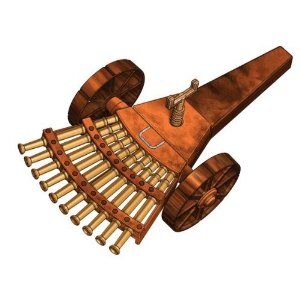
Leonardo da Vinci machine gun model
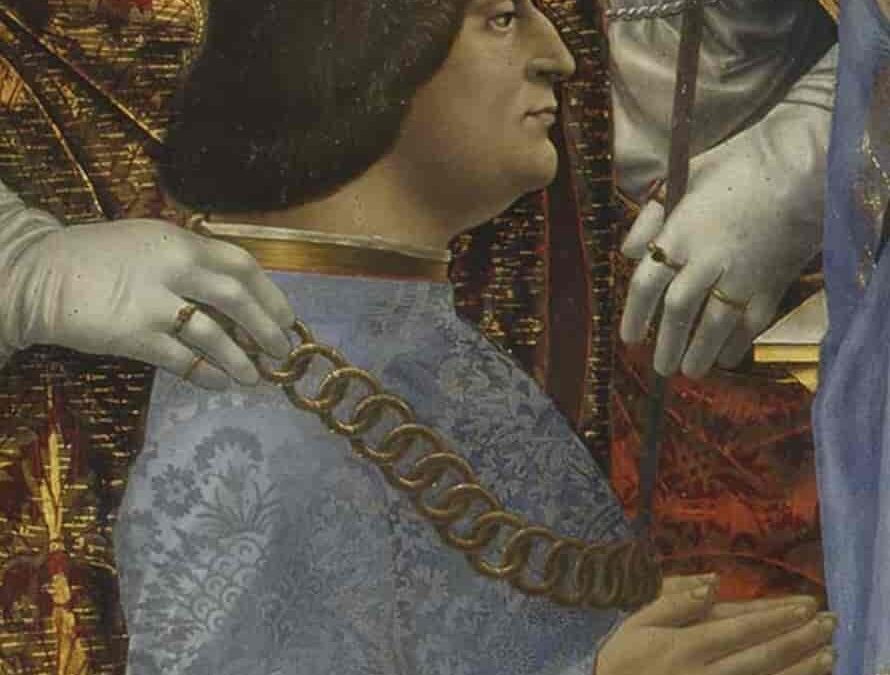
Ludovico Sforza is a remarkable figure of the Italian Renaissance. The full name of Ludovico Sforza is Ludovico Maria Sforza, also known as il Moro. He served as the Duke of Milan from 1494 to 1499. A dynamic duke, ambitious patron, and compelling political player, Sforza’s life and reign left a lasting mark on the annals of history.
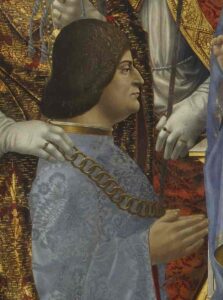
Ludovico Sforza (1452-1508)
Born into the notable Sforza family in 1452, Ludovico Sforza grew up in the epicenter of Renaissance Italy’s power struggles. As the second son of Francesco Sforza, the Duke of Milan, Ludovico was not initially destined for leadership. However, fate had a different course charted for this ambitious scion.
Ludovico was more than a statesman; he was a humanist, deeply influenced by the intellectual currents of the time. His education was well-rounded, encompassing subjects from the humanities to the arts. This broad knowledge base would later serve as the foundation for his rule and patronage, impacting not only Milan but also the broader European Renaissance.
The path to power for Ludovico Sforza was fraught with strife, stemming from the complex political landscape of 15th-century Italy. After the death of his elder brother, Galeazzo Maria Sforza, the ducal title fell to Galeazzo’s young son, Gian Galeazzo. However, the astute and ambitious Ludovico, unconvinced that a child could effectively govern Milan, seized the opportunity to claim the reins.
He appointed himself as the Regent on behalf of his young nephew, effectively taking control of Milan’s governance. However, his ambition didn’t stop there. With careful maneuvering, Ludovico managed to seize the title of Duke in 1494, seven years before the death of Gian Galeazzo. His rule as Duke would see Milan become one of the leading cities in Italy, a shining beacon of the Renaissance and a testament to the skill and ambition of Duke Ludovico Sforza.
One of Ludovico Sforza’s most enduring legacies was his patronage of the polymath genius, Leonardo da Vinci. Recognizing Leonardo’s unmatched talent, Ludovico invited him to Milan in 1482. This planned move was not merely about collecting art; it was a strategic endeavor to augment the cultural prestige of his court and city.
Under Sforza’s patronage, Leonardo da Vinci flourished as a painter, sculptor, architect, engineer, and scientist. Besides producing iconic art, Leonardo was involved in several projects, ranging from developing military strategies to designing canal systems. His diverse roles under Ludovico’s rule showcased his talents far beyond the realm of painting.
Leonardo’s tenure in Milan under Ludovico’s patronage led to the conception of several groundbreaking projects and inventions. His works spanned numerous disciplines, including civil engineering, aeronautics, and military science. His sketches of ‘flying machines’ inspired future generations of aviation, while his designs for war machines revolutionized military engineering.
While serving Ludovico, Leonardo da Vinci created some of his most celebrated works. These include the iconic ‘The Last Supper’, a mural that continues to captivate audiences with its emotional depth and compositional innovation. Leonardo also began the monumental project of a horse statue, known as the ‘Gran Cavallo’, which, although never completed, symbolized the ambition and grandeur of the Sforza court.
Another notable work is the ‘Madonna Litta’, a testament to Leonardo’s mastery over the portrayal of human emotion. Additionally, the Codex Atlanticus, a collection of Leonardo’s drawings and writings, compiled during his time in Milan, serves as an extraordinary record of Renaissance ideas.
As a visionary patron, Ludovico Sforza realized the potential of art to enhance the cultural stature of Milan. His tenure saw an unprecedented surge in artistic creativity, marking Milan as a beacon of the Renaissance movement. From the recruitment of talented artists to the commissioning of large-scale public works, Sforza’s influence was instrumental in shaping the artistic landscape of the era.
While the Medici family in Florence and the Borgia family in Rome were also notable patrons of the Renaissance, Ludovico’s patronage had a distinctive flair. Unlike his contemporaries, Sforza sought not only to commission works but also to create a vibrant cultural hub that fostered innovation.
The Medici, most notably Lorenzo de’ Medici, also known as ‘Lorenzo the Magnificent’, were great patrons of artists such as Sandro Botticelli. However, their focus was more on consolidating their political power, whereas Ludovico aimed to transform Milan into a renowned center of art and learning.
On the other hand, the Borgia family, including the infamous Cesare Borgia, were more notorious for their political machinations than their artistic patronage. Compared to them, Sforza’s patronage was more sophisticated and art-centered.
Under Sforza’s patronage, Milan attracted a wide range of artists and thinkers. Besides Leonardo da Vinci, other prominent artists of the time, including Michelangelo, Raphael, Titian, Giovanni Bellini, and Fra Angelico, also benefited from the vibrant cultural atmosphere that Sforza fostered.
The name Sforza carries a deep significance in Italian history, directly translating to “force” or “strength” in English. This moniker perfectly embodies the boldness and fortitude that defined the Sforza family, particularly Ludovico, as they cemented their position in the annals of the Italian Renaissance.
Pronunciation often acts as a bridge to understanding and appreciating the nuances of different cultures and languages. To pronounce “Sforza,” focus on the “Sf” sound, followed by “or-za” – /ˈsfɔrt.sa/.
The full name, Ludovico Sforza, incorporates an Italian masculine given name “Ludovico,” which should be pronounced as /luˈdɔː.vi.ko/. Therefore, the correct pronunciation for the entire name is /luˈdɔː.vi.ko ˈsfɔrt.sa/.
Ludovico Sforza has found his way into the popular imagination through many channels, one of the most notable being his representation in the TV series “The Borgias.” This series portrays Sforza as a shrewd and power-hungry duke, highlighting his strategic mind and political acumen. It must be remembered, however, that while the series is rooted in history, it employs creative license to dramatize events and personalities.
The enduring legacy of Ludovico Sforza also shines through the world of luxury accessories. Montblanc, a company synonymous with exquisite writing instruments, paid homage to Sforza by releasing a special edition pen named after him. The Montblanc’s Ludovico Sforza edition pen encapsulates the essence of the Renaissance with its intricate design, reflecting the grandeur and opulence of the era. Owning this pen is akin to holding a piece of history, an artifact that symbolizes the influence and significance of Ludovico Sforza.
The Sforza family wasn’t just a footnote in the history of the Renaissance – they were one of its principal drivers, significantly shaping the cultural and intellectual revolution. The Sforza, particularly under the rule of Ludovico Sforza, provided a nurturing environment for arts, literature, and innovation, propelling Milan to be one of the leading city-states during the Renaissance. Their patronage attracted luminaries like Leonardo da Vinci and made Milan a vibrant center of creativity.
The influence of the Sforza family today may not be as monumental as it was during the Renaissance, but they have undoubtedly left an indelible mark on history. While they no longer rule Milan, traces of their legacy can still be seen across the city, from the grand Sforza Castle, a significant historical landmark, to the numerous art pieces in museums that came into being due to their patronage. Furthermore, the Sforza family’s descendants continue to bear the prestigious name, a lasting reminder of their forebears’ substantial influence during one of humanity’s most creatively abundant eras.
In the grand tapestry of the Renaissance, Ludovico Sforza holds a place of prominence, a catalyst who sparked and nourished one of humanity’s greatest outpourings of creative genius. From his rise to power to his active support for the arts, Sforza’s actions and influence reshaped Milan, turning it into a beacon of culture, art, and innovation.
His foresight in recruiting Leonardo da Vinci, a figure now synonymous with Renaissance brilliance, speaks volumes of his commitment to nurture talent and innovation. His patronage led to the creation of some of the most iconic artworks in history, while also fostering advancements in engineering, warfare, and aeronautics.
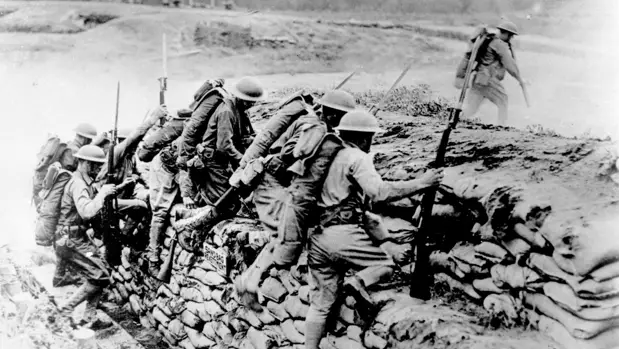
World War I, also known as the Great War, is a monument in the annals of human history. It was a war unlike any that had come before, dwarfing previous conflicts in its sheer scale and the massive shifts in power it brought about. This war was not confined to distant battlefields or foreign lands but spilled into everyday life, irrevocably altering the world and the course of the 20th century. But what year was World War I? What were the World War I causes, and who were the World War I countries that participated in this vast conflict?

World War I (1914-1918)
World War I unfurled over a period of four long, hard-fought years. The World War I dates that anchor our understanding of this global conflict stretch from July 28, 1914, to November 11, 1918. These years saw a seismic shift in the landscape of international relations and warfare.
During the years of the war, numerous significant events shaped the course of history. Let’s take a quick journey through the key points on the World War I timeline:
This period was riddled with conflict and dramatic changes. In each of these pivotal moments, the fate of the World War I countries hung in the balance, their futures hinging on the events of this war.
Any exploration of how did World War I start must address the complex web of political, social, and economic factors that led up to the outbreak of hostilities. It wasn’t a single incident but rather a dangerous confluence of events and pressures that plunged the world into this momentous conflict.
The spark that ignited the powder keg of World War I was the assassination of Archduke Franz Ferdinand of Austria-Hungary. On June 28, 1914, the heir to the Austro-Hungarian Empire was assassinated by a Bosnian Serb nationalist named Gavrilo Princip in Sarajevo. This act of violence sent shockwaves through the already tense European landscape, precipitating a series of declarations of war that quickly encompassed the globe.
While the assassination provided the immediate spark, the fuel for the fire was years in the making. Among the primary causes of World War I were the potent forces of militarism, alliances, imperialism, and nationalism:
Delving deeper into the causes of World War I, experts can identify seven key factors that led to the outbreak of the conflict:
In asking, “who fought in World War I?”, we must identify the key nations and alliances that shaped the conflict. The war’s combatants were divided into two main groups: The Central Powers and the Allied Powers.
World War I involved many nations across the globe, earning its designation as a ‘world war’. The countries involved in World War I spanned multiple continents, from the trenches of Europe to the oceans of the Pacific. Major participants included Germany, Austria-Hungary, and the Ottoman Empire among the Central Powers, and France, Britain, Russia, and later the United States among the Allies.
The Central Powers, centered in Central Europe and the Middle East, primarily comprised Germany, Austria-Hungary, the Ottoman Empire (modern-day Turkey), and Bulgaria. They were characterized by their central geographical location and shared political interests.
On the other side of the conflict were the Allied Powers, a coalition that included the United Kingdom, France, Russia, Italy, Japan, and, from 1917, the United States. Numerous other countries also supported the Allies, from large empires like India (then a part of the British Empire) to smaller nations such as Belgium and Serbia.
During World War I, the world map was dramatically different from what we know today. Many nations involved in the conflict held extensive overseas empires. For example, Britain’s territories spanned the globe, and France controlled vast regions in Africa and Asia. Even the Ottoman Empire, largely forgotten in the present day, extended across much of the Middle East and North Africa.
A common question when studying World War I is “why did Germany start WWI?”. To answer this, it’s essential to explore the geopolitical landscape of Europe at the time, as well as Germany’s ambitions and its relationships with other nations.
In the early 20th century, Germany, under the leadership of Kaiser Wilhelm II, was a rapidly rising power, both economically and militarily. With ambitions of becoming a global empire, it sought to challenge the dominance of established powers like Britain and France.
Germany’s policy of ‘Weltpolitik’ or ‘world politics’ aimed at acquiring overseas colonies and expanding its influence, leading to tensions with other imperial powers. Its involvement in the arms race, particularly its naval expansion, further exacerbated these tensions.
Furthermore, Germany’s alliance with Austria-Hungary, known as the Dual Alliance, drew it directly into conflict following the assassination of Archduke Franz Ferdinand. When Austria-Hungary declared war on Serbia, Germany was bound by treaty to support its ally, leading to a domino effect of war declarations across Europe.
The country blamed for WWI is typically Germany, as reflected in the Treaty of Versailles, the peace agreement that ended the war. The treaty held Germany and its allies responsible for all “loss and damage” suffered by the Allies during the war. This controversial ‘war guilt clause’ imposed heavy reparations on Germany and has been the subject of debate among historians ever since.
However, it’s crucial to understand that while Germany played a significant role, the causes of World War I were complex and multifaceted, involving a web of alliances, rivalries, and tensions that spanned many years and numerous countries.
To truly grasp the magnitude of World War I, it’s necessary to delve into the question: “What happened in World War I?” This war reshaped the world and saw many significant events and battles that are critical to understanding its course and outcome.
The conflict, famously known as the ‘Great War’, began with the assassination of Archduke Franz Ferdinand of Austria-Hungary in June 1914. This triggered a chain reaction of war declarations due to a complex system of alliances.
The early part of the war saw a mobile but costly phase known as the ‘War of Movement’, including the Battle of the Marne where the French and British forces halted the German advance towards Paris. However, by the end of 1914, the war on the Western Front had bogged down into a static trench warfare, extending from the Swiss border to the English Channel, in what became known as the ‘War of Attrition’.
Significant events that marked turning points in the war include the Battle of Verdun in 1916 – one of the longest and bloodiest battles of the war; the entry of the United States into the war in 1917 providing fresh troops and resources for the Allies; and the launch of Germany’s Spring Offensive in 1918 in an attempt to end the war before American forces arrived in significant numbers. The offensive failed, leading to the Hundred Days Offensive, which pushed the German armies back and ultimately led to the war’s end.
Apart from the aforementioned battles, World War I saw numerous significant confrontations that profoundly affected its course. For instance, the Battle of the Somme in 1916 was one of the deadliest battles, causing over a million casualties and failing to achieve the strategic breakthrough the Allies had hoped for.
The naval Battle of Jutland in 1916, the largest naval battle and the only full-scale clash of battleships in the war, confirmed British naval dominance and isolated the German fleet for the remainder of the war. The successful use of tanks, Mark I tank, at the Battle of Cambrai in 1917 demonstrated a new way of warfare, hinting at future mechanized warfare.
Each of these events and battles played a critical role in shaping the outcome of World War I, affecting the lives of millions and altering the course of world history.
As we navigate through the complex narrative of World War I, an inevitable question arises: “Who won World War I?” The answer to this question is intertwined with the examination of the outcomes and the peace treaties that followed this devastating conflict.
The primary victory in World War I was claimed by the Allied Powers, consisting of countries such as France, the United Kingdom, Russia, and later the United States, Italy, and Japan. After Germany’s unsuccessful Spring Offensive and the successful Allied Hundred Days Offensive, the war swung decisively in favor of the Allies. Faced with internal unrest and Allied advances, Germany sought an armistice, or cessation of fighting, which came into effect on November 11 1918.
The formal end of the war was marked by several peace treaties with the Central Powers, the most significant of which was the Treaty of Versailles with Germany. The treaty held Germany and Austria-Hungary responsible for the war and imposed heavy financial reparations and territorial losses on them.
However, the punitive terms of the Treaty of Versailles were highly controversial. Many, including British economist John Maynard Keynes, believed it was too harsh and would lead to further conflict. Indeed, the societal and economic upheaval it caused in Germany is often cited as one of the causes of World War II.
The end of World War I was not marked by a decisive victory but rather by the exhaustion and collapse of the Central Powers. By late 1918, after four years of relentless warfare, the economies and societies of Germany and Austria-Hungary were on the brink of collapse. Uprisings and mutinies erupted in Germany, Austria-Hungary, and Ottoman Empire, making it impossible for these countries to continue the war.
Under these conditions, an armistice was signed between Germany and the Allies on November 11, 1918, effectively ending the fighting on the Western Front. Over the next few years, a series of peace treaties were signed with the individual Central Powers, formally ending their state of war with the Allies and reshaping the map of Europe and the Middle East. These treaties, however, sowed the seeds of further conflict and upheaval that would once again engulf the world just two decades later.
While the war on the battlefield was brutal, the aftermath of World War I brought about a seismic shift on various fronts, impacting not just the “world war I countries” but the entire world at large. Let’s take a closer look at the social, political, and economic changes precipitated by the war and touch upon some key “world war I facts”.
It is estimated that about 20 million people died during World War I. This figure includes both military personnel and civilians. This horrific loss of life was due to the intense fighting on the front lines, but also to diseases like the Spanish flu, and genocides, like the Armenian Genocide in the Ottoman Empire.
The legacy of World War I is far-reaching. It irreversibly altered the geopolitical landscape, led to the rise of the United States as a global power, and served as a precursor to the establishment of international organizations aimed at preserving peace, such as the League of Nations, and later, the United Nations. The war also gave rise to significant advancements in technology and warfare, the echoes of which are still visible in today’s world.
For a more immersive experience on this topic, a visit to the “world war I museum” – The National World War I Museum and Memorial in Kansas City, US, is highly recommended.
World War I left an indelible mark on human history, and museums around the globe have worked tirelessly to preserve and present the tales of heroism, horror, and humanity that arose from the Great War. These “World War I museums” offer a gateway to the past, allowing us to explore the complex narrative of the war.
| Museum | Location | Description | Website |
|---|---|---|---|
| The National World War I Museum and Memorial | Kansas City, Missouri, United States | Houses one of the largest collections of WWI artifacts in the world. Presents an array of personal objects, weapons, vehicles, uniforms, and artwork from the era. The museum’s exhibitions offer an engaging overview of the war, covering its causes, the countries involved, and its aftermath. | The National World War I Museum and Memorial |
| In Flanders Fields Museum | Ypres, Belgium | Named after the famous war poem by John McCrae. Focuses on the brutal battles fought in the Ypres Salient and the human experiences of the war. Located in the Cloth Hall, a historic building heavily damaged during the war and later rebuilt. | In Flanders Fields Museum |
| Imperial War Museum | London, United Kingdom | Has an extensive collection of war-related artifacts, art, and stories. Its World War I exhibits provide visitors with a comprehensive understanding of the conflict, exploring various perspectives—from soldiers on the front lines to those on the home front. | Imperial War Museum |
| The Australian War Memorial | Canberra, Australia | Commemorates the sacrifice of Australians who have died in war. The museum’s WWI galleries showcase an array of artifacts, including the famous ‘G for George’ Avro Lancaster bomber, photographs, film, and personal memorabilia, shedding light on Australia’s significant contribution to the war. | The Australian War Memorial |
Visiting these museums offers an opportunity to delve deeper into understanding World War I’s profound impacts, paying respects to those who gave their lives during this tumultuous period in history.
World War I, often called ‘The Great War,’ stands as one of the most significant and influential events of the 20th century. Its reverberations were felt far beyond the battlefields, reshaping the world in ways that continue to be felt today.
From the ashes of the war, the world map was redrawn, old empires collapsed, and new nations were born. The conflict fueled revolutionary change in technology, industry, and warfare, marking the advent of tanks, aircraft, and other forms of mechanized combat. Society and culture were transformed as women entered the workforce in unprecedented numbers, and a generation of writers and artists reflected on the war’s horrors in their works, sparking modernist movements in literature and the arts.
The war’s political consequences were no less dramatic. The Russian Revolution of 1917 was, in part, a result of the economic and social strain of the war. In the Middle East, the collapse of the Ottoman Empire led to a complex legacy still unfolding today. Perhaps most ominously, the punitive measures of the Treaty of Versailles sowed the seeds of resentment in Germany, setting the stage for the rise of National Socialism and the onset of World War II.
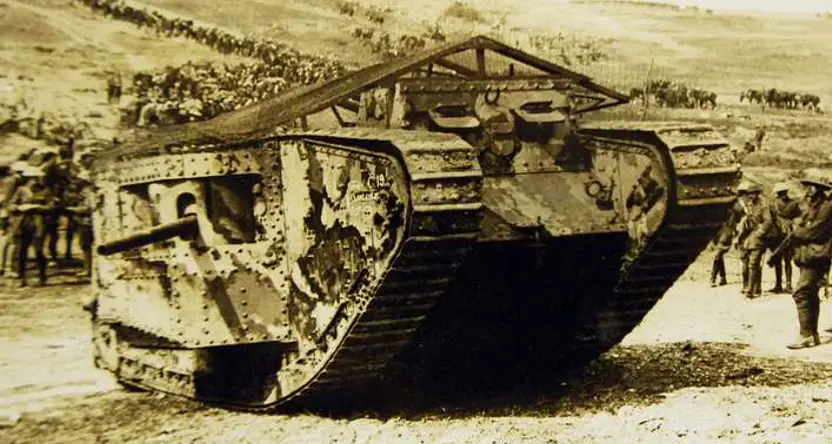
In the chronicles of military history, the Mark I tank stands tall as a revolutionary invention that forever altered the dynamics of warfare. Born amidst the chaos of World War I, this British innovation was not just a new piece of machinery; it was a symbol of radical change, a testament to human ingenuity in the face of adversity. This steel leviathan was designed to navigate the rutted landscapes and trench networks that characterized the Western Front. Prior to its invention, these trenches, a grim hallmark of World War I, had stymied the armies of both sides, leading to a devastating stalemate.

Mark I tank in WW1
However, the introduction of the Mark I tank on 15 September 1916 signified a shift in the tide. Its combination of armored protection, firepower, and all-terrain mobility gave birth to a new era of mechanized warfare, freeing soldiers from the deadly entrapment of trench warfare. The Mark I tank, therefore, became the blueprint for all future tanks, paving the way for successors like the Mark II and Mark IV tanks, right up to the Mark VIII tank. Each iteration, while different in specific design and capabilities, carried forward the legacy of the original Mark I.
The Mark I tank holds a crucial place in the annals of military technology. It demonstrated that necessity, truly, is the mother of invention. In the darkest hours of World War I, it shone as a beacon of hope and marked a profound evolution in how battles would be fought in the years to come. Just as the innovations of Leonardo da Vinci were pivotal in his time, the Mark I tank was, and remains, a watershed in ours.
World War I (WW1) saw the emergence of new technologies that forever changed the nature of warfare, among which the Mark I tank was undoubtedly the most revolutionary. The brutal stalemate of trench warfare demanded an innovative solution, and in response, the Mark I tank was born.
When the Mark I tank was introduced to the battlefield in 1916, it brought an abrupt end to the age of static warfare. The tank, with its caterpillar track design, could navigate the treacherous terrain of the battlefields, clearing paths over trenches and through barbed wire defenses. This ability, coupled with its heavy armor and artillery, made it an intimidating force against the German lines.
The Mark I tank had the element of surprise on its side. Its debut on the battlefield at the Battle of Flers-Courcelette caught the Germans off guard, leaving them ill-prepared to counter this new form of warfare. The tank’s psychological impact was as significant as its physical one, shaking the resolve of the German forces and signaling the beginning of a shift in the momentum of the war.
The Mark I tank was a force to be reckoned with. Its maximum speed was around 3.7 mph on flat terrain, a slow but steady pace that mirrored the grim determination of the British forces. Despite its lumbering pace, the tank’s unique ability to traverse difficult terrain made it a formidable tool on the battlefield.
The tank’s firepower was equally impressive. The Mark I was armed with two 6-pounder guns and multiple machine guns, making it a mobile fortress capable of delivering a devastating blow to enemy fortifications. Its armored shell could withstand small arms fire and shrapnel, protecting the crew within.
This combination of robust defenses and potent offensive capabilities was unprecedented at the time, and placed the Mark I tank in a league of its own. Just like how Leonardo da Vinci’s inventions broke boundaries in their era, the Mark I tank shattered the conventional wisdom of war, marking a new chapter in military history.
The evolution of tanks during World War I was a testament to the rapid advancement in military technology, marked by incremental improvements and strategic variations. Among the most significant of these were the British Mark series tanks and the German tanks.
| Model | Key Features | Use in Combat |
|---|---|---|
| Mark I | First armored vehicle designed for frontline combat. | Used in World War I |
| Mark II | Slight modifications to the Mark I. Primarily used for training. | No combat usage |
| Mark III | Improved armor protection and better living conditions for the crew. | No combat usage |
| Mark IV | Thicker armor, improved fuel systems, and more reliable weaponry. | Used in World War I |
| Mark V | New transmission system for easier control and increased speed. | Used in World War I |
| Mark VI | Designed, but never made it past the prototype stage. | No combat usage |
| Mark VIII ‘Liberty’ | Thicker armor, more powerful engine, a collaborative effort with America. | No combat usage during World War I, but used later |
Germany’s response to the British Mark series came in the form of the A7V. Compared to the Mark I tank, the A7V was significantly faster, able to reach speeds of up to 9 mph. It was also equipped with a main gun and six machine guns, offering a formidable mix of firepower.
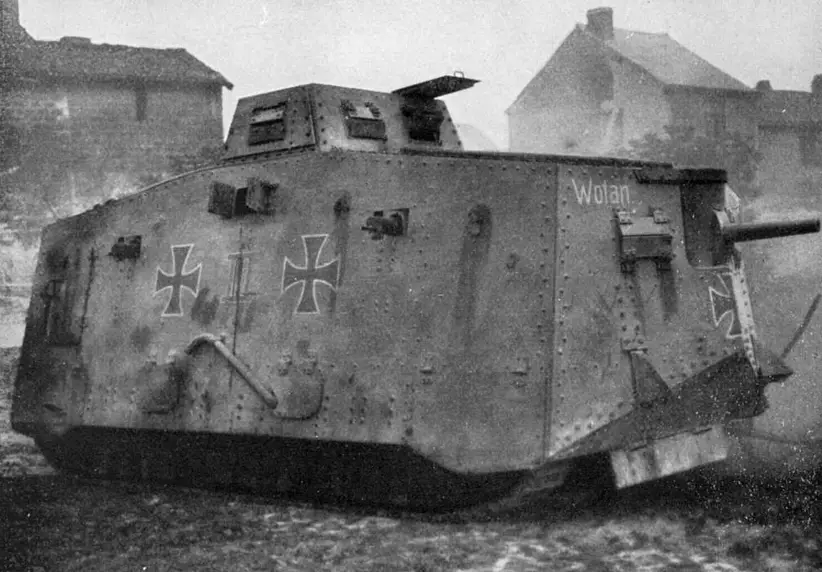
German A7V tank
However, where the Mark I and its successors had the advantage was in their ability to traverse difficult terrain due to their caterpillar track design. The A7V, in contrast, struggled with trenches and uneven landscapes.
From the imposing Mark I tank to the late arrival of the Mark VIII, each iteration reflected a continuous process of learning and adaptation. They stood as symbols of the drive for innovation, much like the inventions of Leonardo da Vinci that pushed the boundaries of what was thought possible. Similarly, the German A7V was a clear testament to the speed with which nations adapted to the changing nature of warfare during this period.
The course of history has seen tanks evolve from the rudimentary designs of World War I to the technologically advanced machines of today. While there have been many formidable tanks, there have also been those that were less successful on the battlefield.
In the realm of WW1 tanks, the French FT-17 often comes to mind when discussing weaker models. While revolutionary in its own right for introducing the classic turret design, the FT-17 was lightly armored and armed only with a machine gun or a light cannon, making it less effective against fortified positions and virtually defenseless against other tanks.
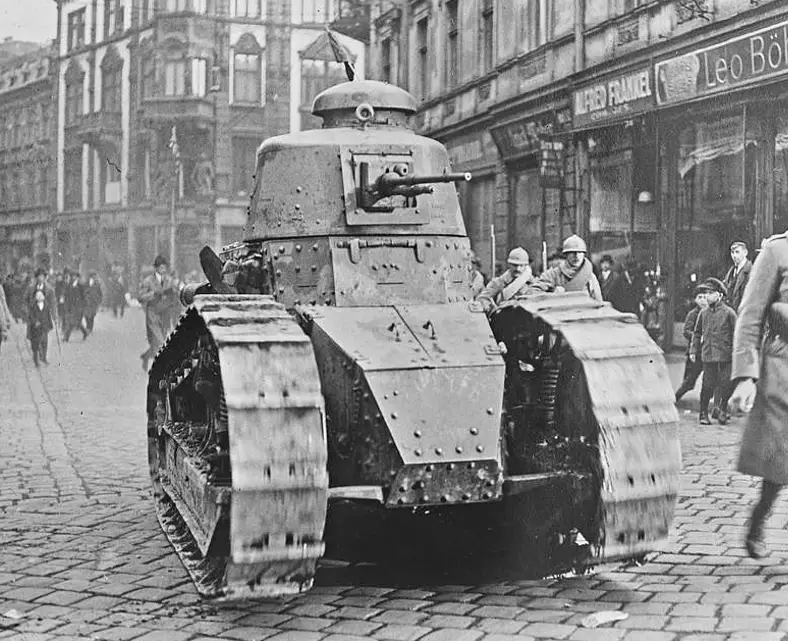
French FT-17 tank
Beyond World War I, the Italian L3/35 of World War II is often cited as one of the weakest tanks ever produced. Despite its impressive mobility, the L3/35 was severely under-armored and under-gunned, with its twin machine guns providing little threat to enemy tanks or fortified positions.
When it comes to effectiveness, the T-34, a Soviet tank of World War II, is often hailed as one of the best. It combined a robust design with wide tracks (ideal for the Eastern Front’s harsh terrain), a powerful 76.2mm gun, decent speed, and sloped armor that increased the tank’s defensive capabilities. The T-34 was a testament to the effectiveness of straightforward design and mass production, and it played a crucial role in the Soviet Union’s defensive and offensive operations.
Modern tanks in the post-WWII era, the T-72 stands out as one of the Soviet Union’s most effective tanks. With over 20,000 units produced since its introduction in the late 1960s, the T-72 boasts a powerful 125mm smoothbore gun, composite armor, and a compact design, making it one of the most widely used tanks in history.
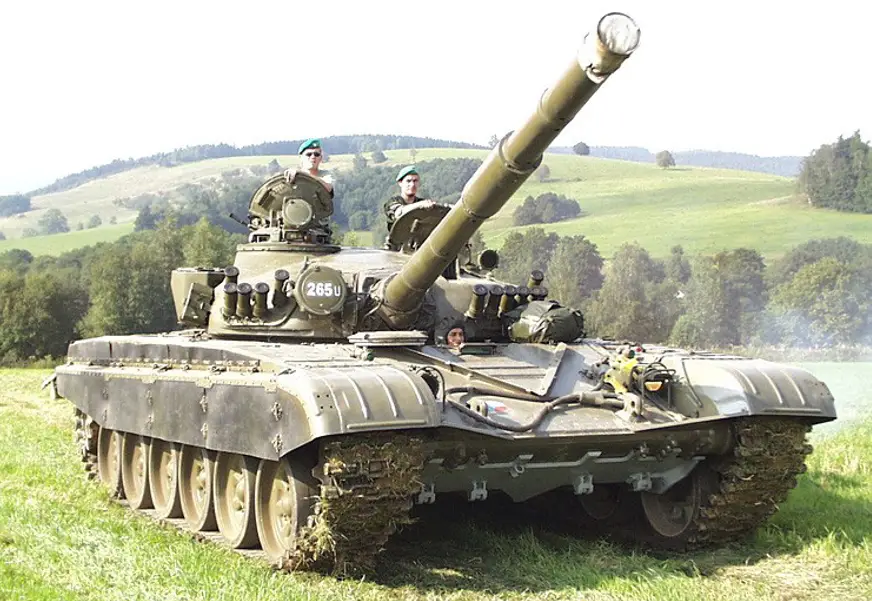
T-72 tank
The analysis of tank designs, from the weakest to the most effective, mirrors the trajectory of human innovation. Each model, regardless of its success or failure, represents a stepping stone towards progress, much like how the creations of Leonardo da Vinci helped shape the future of human invention.
The dawn of mechanized warfare was symbolized by the advent of the Mark I tank in World War I. As the first armored vehicle designed for frontline combat, it marked a seismic shift in the tactics and strategy of warfare. The Mark I tank was not just a response to the specific challenges of trench warfare; it was a blueprint for the future.
The significance of the Mark I tank cannot be overstated. It laid the groundwork for successive generations of tanks, starting from the Mark II to the Mark VIII and beyond. It influenced the design of the German WW1 tank and was a precursor to the formidable tanks of World War II.
In the broader context of human history, the development of the Mark I tank shares parallels with the evolution of Leonardo da Vinci’s inventions. Just as da Vinci’s creations pushed the boundaries of what was considered possible in his time, the Mark I tank expanded the horizons of military strategy, forever altering the landscape of warfare. It stands as a testament to the boundless potential of human innovation when faced with the most formidable challenges.
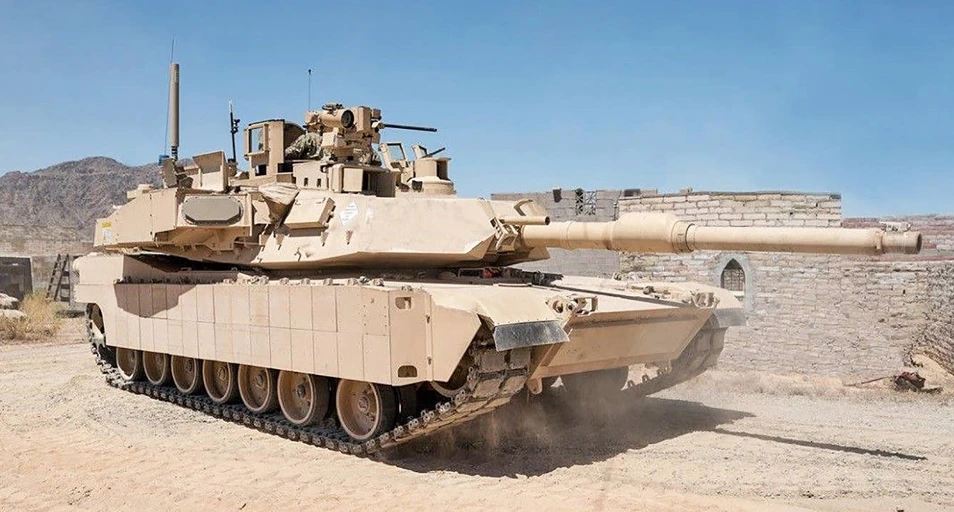
Modern tanks, the successors of early 20th-century armored beasts, now dominate 21st-century battlefields. Evolved from World War I origins, these military goliaths, armored and armed, are symbols of contemporary warfare’s power and precision, symbolizing a fascinating journey from mechanical infancy to technological pinnacle.
From their infancy as slow, lumbering metal boxes to the swift, technologically sophisticated powerhouses of today, the story of tanks is a journey marked by innovation and adaptation. The tanks of the modern era are a far cry from their early predecessors, both in terms of capabilities and design. For example, consider the conceptual designs of Leonardo da Vinci, a man far ahead of his time. Da Vinci’s designs hinted at the potential of armored warfare, a potential fully realized in the modern tanks we see today.
A tank that embodies this leap in technology is the T-14 Armata, a shining example of the latest in Russian modern tank design. When we peel back its layers, we find that beneath the Armata’s menacing exterior lies a symphony of high-tech features. Its unmanned turret, a groundbreaking feature, is controlled remotely from within the tank, providing an unprecedented level of safety for its crew.
As we move westwards, we come face to face with another giant in modern tank technology: the M1A2 SEP v3 Abrams. This modern US tank features a range of improvements over its predecessor, including enhanced armor and high-tech systems that increase its effectiveness on the battlefield. With a new ammunition data link for improved targeting and an Auxiliary Power Unit (APU) for increased efficiency, the Abrams is an impressive showcase of US engineering prowess.
But technological mastery isn’t confined to the West. The East has its own mechanical marvel in the form of the Type 10, a modern Japanese tank that fuses high-tech weaponry with cutting-edge defensive capabilities. With advanced Composite Armour and a digital battlefield management system, the Type 10 stands tall as a testament to Japan’s technological prowess.
Stepping onto the global stage, we find a lineup of the world’s best modern tanks, each a paragon of their respective nation’s ingenuity and military prowess. From the Abrams tank of the United States to the Leopard tank of Germany, these modern tanks are the linchpins of their countries’ land warfare strategies.
First up is the modern US tank, the M1A2 SEP v3 Abrams. This beast of a machine is like a mechanical Hercules, known for its strength and durability. The Abrams boasts impressive firepower and can absorb heavy punishment with its advanced composite armor. A testament to the United States’ military might, the Abrams remains one of the top contenders in the world of modern tanks.
Moving to Europe, we find Germany’s answer to the Abrams: the Leopard 2A7. Known as one of the best modern German tanks, the Leopard combines speed, maneuverability, and impressive firepower. Its high-velocity 120mm gun ensures it packs a punch, while its advanced protection systems mean it can hold its own in a slugfest.
Shifting our gaze eastwards, we find the T-14 Armata, a shining example of modern Russian tanks. With its unmanned turret and next-generation armor, the Armata represents a step forward in tank technology, displaying a unique blend of power and innovation that marks Russia’s place in modern tank warfare.
Next up is the Challenger 2, the stalwart of modern British tanks. Renowned for its exceptional durability, the Challenger 2 holds the record for longest tank-to-tank kill. Its combination of superb armor and reliable systems make it a formidable component of the UK’s military arsenal.
From France comes the AMX Leclerc, a modern French tank that merges speed, technology, and firepower. Known for its high level of automation and excellent mobility, the Leclerc is a symbol of French sophistication and military know-how.
Finally, we turn to the Far East, where the Type 10, a Japanese modern tank, stands out with its advanced digital systems and high-tech armor. The Type 10’s compact design and excellent maneuverability make it well-suited for Japan’s rugged terrain, showcasing the country’s innovative approach to tank design.
Each of these tanks, from the robust Abrams to the technologically advanced Type 10, brings its unique strengths to the battlefield. This variety and specialization are a reflection of the complex nature of modern warfare, where different situations call for different tools. As we move forward, these tanks will continue to evolve, a testament to the ever-changing nature of warfare and the relentless drive for advancement.
Among the world’s modern tanks, the Abrams tank, a key player in the US’s lineup of modern tanks, stands out. With its imposing silhouette, the Abrams is not just a symbol of American power; it’s a living testament to the United States’ commitment to military superiority.
The Abrams tank, named after General Creighton Abrams, the former Army Chief of Staff, entered service in 1980. Designed to replace the aging M60 Patton, the M1 Abrams was a quantum leap forward in tank technology, boasting advanced armor, high-speed mobility, and immense firepower. Over time, the Abrams has been upgraded and refined, resulting in the current version, the M1A2 SEP v3, a truly modern US tank.
The Abrams tank is an embodiment of raw power. Its 120mm smoothbore gun delivers devastating firepower, while its advanced Chobham armor offers impressive protection. With a gas turbine engine that can propel it at speeds up to 60 mph, the Abrams is as swift as it is deadly.
On the technology front, the Abrams is equally impressive. Its advanced fire control system allows for accurate targeting in both day and night conditions, while its suite of sensors and systems provides a level of situational awareness unparalleled among tanks.
The Abrams’ capabilities aren’t just theoretical; they’ve been tested and proven on the battlefield. From the scorching deserts of Iraq in the Gulf War and subsequent Iraq War to the rugged mountains of Afghanistan, the Abrams has faced a wide range of threats and has consistently emerged victorious.
However, it’s worth noting that the Abrams is not invincible. Has the US ever lost an Abrams tank? Yes, they have. Despite the Abrams’ impressive capabilities, a few have been lost in combat, primarily due to Improvised Explosive Devices (IEDs) and RPGs. Such losses are a stark reminder that even the most powerful tanks have vulnerabilities.
Despite these losses, the Abrams remains one of the most formidable tanks in the world. Its combination of power, protection, and advanced technology make it a key asset in the US military arsenal and a symbol of American military might.
When it comes to the world’s best modern tanks, two names often surface to the top of the list: the American Abrams tank and the German Leopard 2 tank. These mechanical titans, each boasting a mix of speed, power, and armor, represent the pinnacle of their respective nation’s military engineering prowess. But, which one reigns supreme? Is the Leopard 2 better than the Abrams?
Table 1. Comparison between Leopard 2 and Abrams tanks
| Features | Leopard 2 (Germany) | Abrams (USA) |
|---|---|---|
| Nickname | Swift Predator | Ironclad Juggernaut |
| Manufacturer | Germany | United States |
| Main Gun | 120mm smoothbore gun | 120mm smoothbore gun |
| Special Focus | Speed, Agility, and High-Tech Firepower | Superior Armor and Survivability |
| Mobility | Superior – thanks to a powerful multi-fuel engine and advanced suspension system | High – but not specifically highlighted in comparison to Leopard 2 |
| Advanced Tech | Digital fire control systems, advanced optics, and sophisticated thermal imaging system | Advanced fire control system, sensors, and targeting system |
| Armor | Not specified | Advanced composite armor (Chobham armor) |
| Survivability | Not specifically highlighted | High – designed to withstand high-explosive anti-tank (HEAT) rounds and kinetic energy penetrators |
| Ability to Engage Targets | High accuracy in various combat conditions | Accurate in both day and night conditions, can track and engage moving targets while on the move |
| Terrain Versatility | Can traverse challenging terrain at high speeds | Not specified |
Therefore, is the Leopard 2 better than the Abrams? The answer isn’t straightforward. The Leopard 2’s emphasis on speed and advanced technology make it an exceptional offensive weapon, capable of rapid strike and maneuver warfare. The Abrams, with its superior armor and survivability, is an ideal defensive weapon, able to absorb heavy punishment while delivering devastating counterattacks.
In the end, the choice between the Leopard 2 and the Abrams largely depends on the specific mission, terrain, and tactical doctrine. Both tanks represent the zenith of modern tank technology, and each offers a unique blend of capabilities that make it a formidable contender on the battlefield.
Since their inception during the First World War, tanks have experienced an extraordinary evolution. Over the decades, they’ve transformed from slow, lumbering ironclads into technologically advanced powerhouses. Let’s trace this remarkable progression of tank technology, from the early main battle tanks to the modern day tanks we see today.
The evolution of tank technology is a fascinating journey, marked by continuous innovation and adaptation. As we move into the future, it will be interesting to see what new developments await in the world of tanks. From improvements in stealth technology to the potential use of unmanned systems, the story of the tank is far from over.
Over the years, tanks have evolved into highly sophisticated war machines, capable of inflicting massive damage and asserting battlefield dominance. But among these metal beasts, a few stand out as truly lethal — the most dangerous tanks in the world.
Table 2. The most dangerous tanks in the world
| Rank | Name | Country | Nickname | Key Features |
|---|---|---|---|---|
| 1 | Abrams | USA | America’s Shield and Sword | Formidable armor, advanced fire control systems, devastating firepower, a perfect balance of speed, firepower, and protection |
| 2 | Leopard 2 | Germany | Europe’s Swift Executioner | Impressive speed, cutting-edge technology, high-caliber firepower |
| 3 | T-14 Armata | Russia | Russia’s Futuristic Titan | First fully automated tank, unmanned turret, high-tech armor, ability to detect and engage targets from a great distance |
| 4 | Type 99 | China | China’s Eastern Dragon | Advanced composite armor, powerful 125mm smoothbore gun, state-of-the-art electronic warfare systems |
The most dangerous tanks in the world represent a perfect blend of power, protection, and advanced technology. They are the apex predators of modern warfare, bringing a level of destruction and dominance that cements their place at the top of the food chain.
From the plains of Europe to the deserts of the Middle East, modern tanks play an instrumental role in warfare. But which of these armored titans reigns supreme? Let’s delve into the ranks and capabilities of the modern tanks of the world.
Table 3. Ranking of modern tanks
| Rank | Name | Country | Nickname | Key Features |
|---|---|---|---|---|
| 1 | M1 Abrams | USA | America’s Armored Pride | 120mm smoothbore cannon, state-of-the-art composite armor, gas turbine engine (speeds up to 60 mph on highways), exceptional blend of firepower, speed, and defensive capabilities |
| 2 | Leopard 2 | Germany | Europe’s Finest | Reliability, firepower, advanced technology, high-tech features including fire control system and 120mm smoothbore gun |
| 3 | T-14 Armata | Russia | Russia’s Advanced Vanguard | Unmanned turret, remote-controlled gun, new-generation armor offering superior protection, one of the most technologically advanced tanks |
| 4 | Merkava Mk.4 | Israel | Israel’s Desert Shield | Engine at the front for added crew protection, high-performance 120mm gun, advanced armor, unique design focused on crew survival |
| 5 | Type 99 | China | China’s Eastern Juggernaut | Advanced technology, high speed, 125mm smoothbore gun, represents a new generation of Chinese armored warfare |
These modern tanks of the world showcase the pinnacle of armored technology and combat effectiveness. Despite the varying philosophies behind their designs, they all share one thing in common: they are the best in their class, offering unparalleled power on the battlefield.
Modern warfare is a constantly evolving landscape, with nations around the globe always striving to develop superior armored vehicles to maintain battlefield dominance. Let’s dive into the world of the newest U.S. tanks and other modern additions to armored divisions worldwide.
Table 4. Newest tanks rumbling onto the battlefield
| Name | Country | Nickname | Key Features | Status |
|---|---|---|---|---|
| M1A3 Abrams | USA | The Next Generation of U.S. Power | Significant enhancements in terms of weight, power, and digital capabilities | Under Development |
| Leopard 2A7V | Germany | Germany’s Latest Feline | Improved cooling system, new digital systems for increased battlefield awareness, enhanced mine protection | Recently Introduced |
| T-14 Armata | Russia | Russia’s Fully Automated Behemoth | World’s first fully automated tank, high-tech systems, formidable firepower | Recently Deployed |
| Type 15 | China | China’s Lightweight Champion | Designed for operations in rugged terrain and high-altitude regions where heavier tanks struggle | Newest Addition |
The newest U.S. tank and other recent additions to global tank arsenals highlight the ongoing advancements in armored warfare. With each nation bringing unique strengths and technological innovations to the table, the future of tank warfare promises to be as dynamic as it is destructive.
Modern tank technology is not just about firepower and armor. It encompasses advancements in communication, mobility, and energy efficiency. This article delves into the latest advancements that are shaping the future of armored warfare.
In conclusion, the latest military tank technology is revolutionizing the face of armored warfare. With the integration of modern fuel tanks, advanced protection systems, unmanned components, and artificial intelligence, the future of tank warfare promises to be an arena of intense technological competition.
The influence of tanks extends far beyond the battlefield, making substantial impressions on popular culture. From iconic famous tank names in video games to the representation of armored vehicles in art installations, let’s explore the unique intersections of tank culture with the realms of gaming and art.
Modern tank warfare has become a significant part of the gaming industry, with several games offering tank enthusiasts a chance to experience the thrill of armored combat. The globally popular game, “World of Tanks,” features historically accurate famous tank names like the “M1 Abrams,” “Tiger I,” and “T-34,” giving players an immersive experience of controlling these mechanical beasts.
Another prominent example is the “Armored Warfare” game. Set in a modern or near-future era, it allows players to command cutting-edge tanks such as the Leopard 2A7 or the T-14 Armata, accurately simulating their unique capabilities.
Tanks have also rumbled into the realm of art, with the Tate Modern Tanks offering a prominent example. The Tate Modern, a renowned contemporary art museum in London, converted three enormous former oil tanks into unique gallery spaces. These industrial spaces host a variety of installations and performances, bringing a different kind of ‘tank’ into cultural prominence.
In other instances, tanks themselves have become the canvas for artistic expression. For example, the famous T-34 tank, painted pink and adorned with a giant raised middle finger, was a prominent art installation in Prague as a form of protest art.
From their origins in the muddy trenches of World War I to their dominant position on today’s battlefields, tanks have evolved into a crucial component of modern warfare. With the rise of modern tanks, the landscape of combat has been transformed, making them a pivotal part of national defense strategies worldwide.
The top-tier tanks of the world, such as the Abrams and Leopard tanks, are testament to the breathtaking technological advancements and strategic prowess of modern militaries. Despite their differences, these tanks share the common characteristics of unmatched firepower, solid armor protection, superior mobility, and cutting-edge technology. They have played significant roles in modern conflicts and stand as the embodiment of military might and ingenuity.
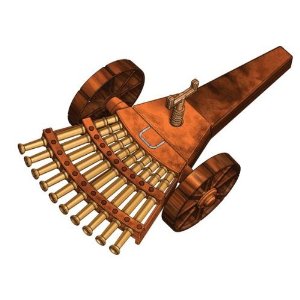

Leonardo da Vinci machine gun model
Leonardo da Vinci machine gun was the first auto-firing weapon ever invented. He designed it so that when it was first fired, another set of barrels would rotate around and be ready to fire almost immediately. Like most of his inventions for war, this machine was supposed to break the spirit of the enemy through fear.
Da Vinci machine gun, 33 submachine gun or organ, is not a machine gun in the modern day. It cannot fire multiple rounds quickly from a single barrel. The weapon behind the machine gun is simple, and Leonardo proposed that 11 Carbines are mounted side by side on a rectangular plate, which is arranged in a triangle, then three such carbines are mounted.
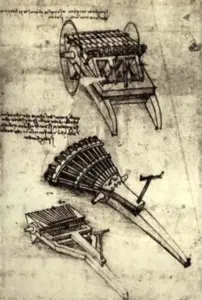
Da Vinci War Machine Drawing
Although Leonardo repeatedly stated in his notebooks that he hated war and the idea of building such a killing machine, he needed money to support his apprentices. Convince its wealthy owners that these machines will help them to defeat the enemy, but the machine gun was never actually built.
In the late 1800s, the first successful designs of machine guns were created. These included the Model 1862 Gatling gun, which was developed by the US Navy and later released to the public. Furthermore, these machines had high rates of fire and mechanical loading. Except for Hiram Maxim‘s recoil-powered machine gun, these weapons required manual operating powers. Dr. Gatling also experimented with externally powered versions of his machine gun; these versions are still used in modern guns.
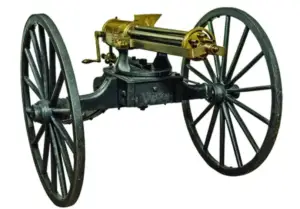
1862 Gatling Gun Model
Edward III’s army used the first ribauldequin, also known as organ gun, during the French Hundred Years’ War that same year. During the Italian Wars, participants used 9-barreled ribauldequin artillery. Additionally, the first ribauldequin possessed 12 barrels with a firing mechanism that contained 12 balls in each barrel.
There are several different types of modern machine guns. These include squad automatic weapons, heavy machine guns, light machine guns, general-purpose machine guns, and medium machine guns.
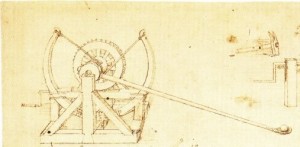
Table 1. Summary of the Leonardo da Vinci Catapult:
| Section | Sub-Section | Key Points |
|---|---|---|
| Introduction | Leonardo and his Catapult | – Explores da Vinci’s genius, focusing on his catapult design. |
| Unveiling the Da Vinci Catapult | Exploring da Vinci’s Innovative Design | – Analysis of da Vinci’s catapult design and its distinct features. |
| Physics Behind the da Vinci Catapult | – Examination of the underlying physics of da Vinci’s catapult. | |
| The Role of Leonardo’s Catapult | Da Vinci’s Intended Use | – Study of the historical application of da Vinci’s catapult. |
| The Catapult in Today’s World | – Overview of how catapults, drawing from da Vinci’s design, are used today. | |
| The Terminology | Understanding the Terminology | – Explanation of various names and titles used to describe da Vinci’s catapult. |
| Unraveling Catapults through History | The First Known Catapults | – Exploration of the first known inventors of the catapult. |
| Tracking Changes in Catapult Blueprints | – Tracks the evolution of catapult designs throughout history. | |
| Catapults in the Middle Ages | – Discussion of the role of catapults in medieval warfare. | |
| Comparing Catapult Designs | da Vinci Versus Mangonel | – Comparison between da Vinci’s catapult and the mangonel. |
| Understanding Mangonel Physics | – Delving into the physics behind the mangonel. | |
| Torsion Catapults | – Analysis of the design and blueprints of torsion catapults. | |
| The Best Catapults Throughout History | – Evaluation of the best and most efficient catapult designs throughout history. | |
| Facts and Curiosities | Fun Facts About Catapults | – Presentation of fun and unusual facts about catapults. |
| da Vinci’s Catapult: Lesser-Known Facts | – Sharing lesser-known facts specifically about da Vinci’s catapult. | |
| Modern Day Uses of Catapults | – Discussion on the uses of catapults in modern times. | |
| Leonardo da Vinci: The Inventor | Da Vinci’s Other Inventions | – Review of da Vinci’s other inventions beyond the catapult. |
| What He Truly Invented | – Analysis of what da Vinci truly invented in his lifetime. | |
| Conclusion | The Impact of Da Vinci’s Catapult | – Recapitulation of the significance and enduring impact of da Vinci’s catapult. |
Leonardo da Vinci’s contributions spanned a plethora of domains, one of which was the art of warfare. Within the folios of his sketches, we find a truly extraordinary machine, a mechanical marvel that was as ingenious as it was intimidating: Leonardo da Vinci’s catapult.
The da Vinci catapult was not a mere device of destruction, but rather a testament to Leonardo’s innovative prowess. It was an embodiment of his fascination with the principles of motion and leverage, a literal manifestation of da Vinci catapult physics.
It did not matter if it was called the Leonardo da Vinci catapult, the da Vinci catapult, or in the mellifluous cadence of his native Italian, the Leonardo da Vinci catapulta. This ingenious war machine marked a paradigm shift in the catapult designs of the era.
Da Vinci’s catapult was a masterstroke of creativity and precision. Unlike the more conventional mangonel catapult designs seen during the period, the da Vinci catapult employed a unique spring mechanism. This consisted of a pair of large leaf springs made of wooden strips, providing a power source that could be adjusted to deliver a range of firing forces.
When released, these springs would drive the armature forward, launching the projectile with greater precision and consistency than earlier designs. As a result, the Leonardo da Vinci catapult marked a significant leap in the evolution of siege warfare, providing a new level of versatility and control.
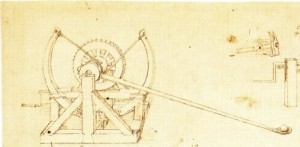
Leonardo da Vinci Catapult
When we delve into the physics of da Vinci’s catapult, it becomes evident how his deep understanding of natural laws allowed him to revolutionize the way catapults were designed and used. The key was in the way he harnessed the potential energy stored in the spring mechanism.
The tightly wound springs of the Leonardo da Vinci catapult could be carefully calibrated, allowing for the precise control of the catapult’s kinetic energy. When the release mechanism was triggered, this stored energy would rapidly convert to kinetic energy, propelling the armature and its payload towards the target. The genius lay in the consistency and control this design afforded, providing a degree of accuracy that was previously unheard of in catapult designs.
The Leonardo da Vinci catapult, like many of his designs, was an idea far ahead of its time. It is important to remember that da Vinci lived during a period when warfare was an all too common occurrence, and siege machines like catapults were essential in battleground strategy. However, Leonardo’s vision of the catapult was not solely for destruction.
The da Vinci catapult, with its precision and adjustable range, could have been utilized for more than just siege warfare. It could deliver supplies over city walls during a blockade or serve as a signal launcher in naval navigation. In essence, Leonardo envisaged the catapult as a versatile tool, not just a weapon of war, demonstrating his comprehensive understanding of the broader applications of his designs.
Fast forward to the present, and we can see the influence of the Leonardo da Vinci catapult in modern engineering and design. Today, the principles of da Vinci catapult physics have found their way into diverse fields, from mechanical engineering to education and entertainment.
In the world of mechanical engineering, the fundamentals of catapult operation serve as a basis for understanding more complex machinery. The concept of storing potential energy and converting it to kinetic energy, central to the function of Leonardo’s catapult, can be found in various mechanisms used today, from automotive engines to power tools.
Even in education, students are often tasked with creating catapult designs, utilizing the same principles employed in the da Vinci catapult to learn about physics and engineering. It’s not uncommon to see a modern davinci catapult in a science fair or physics classroom as a hands-on demonstration of principles like potential and kinetic energy, force, and trajectory.
In the realm of Renaissance engineering and innovation, da Vinci’s designs hold a special place. Among them, the Leonardo da Vinci catapult is often singled out for its unique design and forward-thinking approach to energy conversion. But is there a specific name for this exceptional invention?
Interestingly, while the name ‘da Vinci catapult’ is widely used in popular culture and academia, Leonardo himself didn’t give a particular name to his design. His sketches and notes, dense with insight and overflowing with ideas, were more focused on functionality and design principles rather than nomenclature. Hence, we refer to it by its most descriptive name: the Leonardo da Vinci catapult.
However, it’s worth mentioning that in Italian, the language in which da Vinci wrote his notes, the term ‘catapulta’ is used. So, for Italian-speaking people, the term Leonardo da Vinci catapulta would be the appropriate one. Regardless of the name we use, the ingenuity and innovation encapsulated in this design are universally appreciated.
Another term often associated with da Vinci’s catapult is ‘davinci trebuchet’. A trebuchet is a type of catapult, distinguished by its use of a counterweight to launch projectiles. While da Vinci did design a counterweight-based catapult, his spring-loaded catapult design is a different mechanism altogether. Therefore, the term davinci trebuchet does not correctly apply to the Leonardo da Vinci catapult.
The question of who invented the catapult takes us back to the ancient world. The first known catapults were developed in ancient Greece in the 4th century BC, specifically by a Syracuse engineer named Dionysius the Elder.
These early devices, unlike the da Vinci catapult, relied on torsion power from twisted ropes or sinew rather than tension or counterweights. This type of catapult, also known as a mangonel catapult, used the stored energy in the twisted ropes to hurl projectiles towards the enemy.
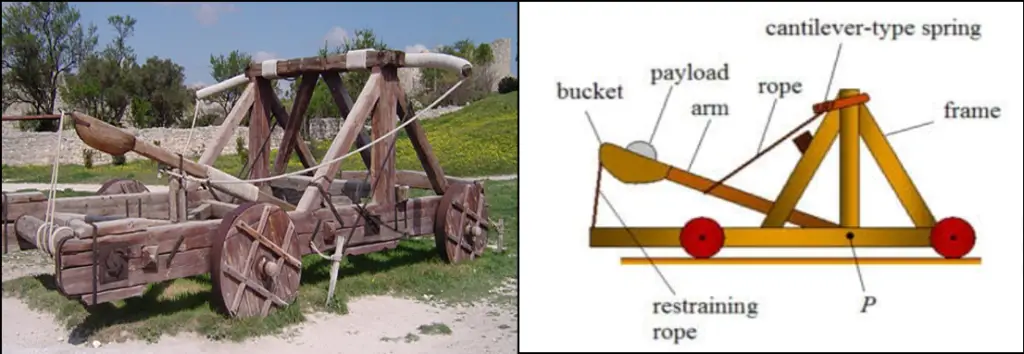
Mangonel Catapult
As centuries passed, catapult design blueprints saw significant changes. Greek and Roman engineers refined and diversified catapult designs, introducing new mechanisms like the ballista and onager. It’s fascinating to compare these classical designs with the more sophisticated da Vinci catapult, a testament to the evolution of engineering over the millennia.
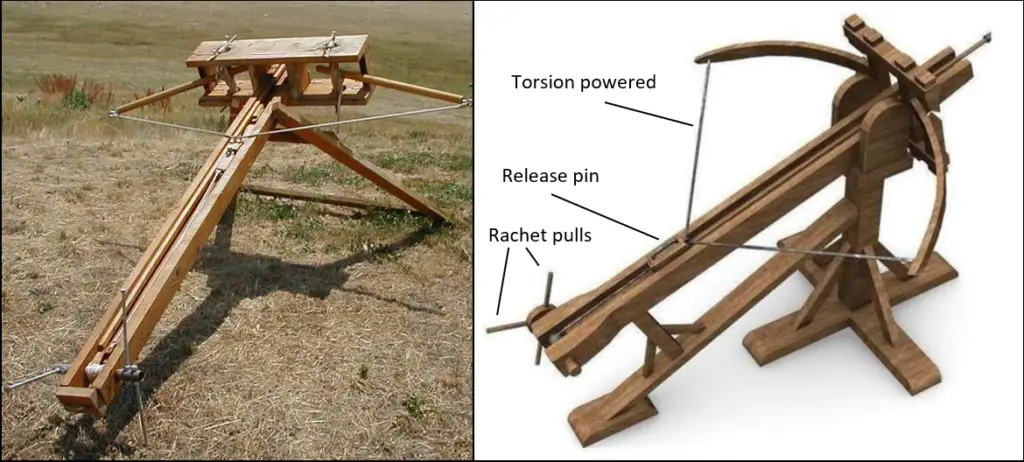
Ballista Catapult
In East Asia, the Mongolians took catapult technology to new heights, creating the Mongolian catapult or Hwacha. This innovation could fire multiple projectiles at once, a stark contrast to the single-projectile designs common in the west.
Entering the medieval period, catapult technology saw another shift. The most prominent type of catapult used in the medieval period was the trebuchet. This siege weapon used a counterweight mechanism, differing from the tension-based design of the da Vinci catapult.
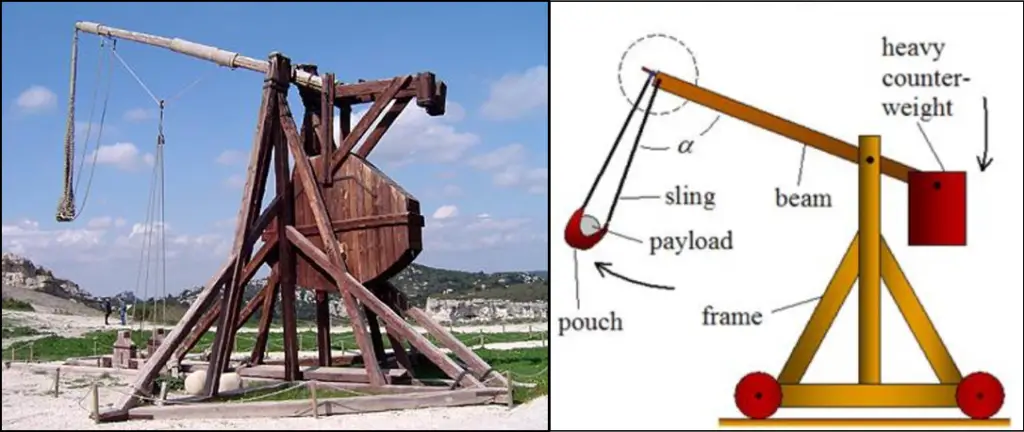
Trebuchet Catapult
Trebuchets represented the apex of medieval siege technology, capable of hurling large projectiles at great distances. The introduction of counterweight technology marked a significant departure from the torsion catapult design of the ancients, leading to more powerful and efficient siege engines.
Despite the differences in design and the centuries that separate them, the trebuchet and the Leonardo da Vinci catapult share a common purpose: to use mechanical advantage to achieve power and precision beyond human capabilities.
| Catapult Type | Propulsion Mechanism | Construction Complexity | Accuracy |
|---|---|---|---|
| Da Vinci Catapult | Spring-like tension mechanism | More complex | High |
| Mangonel | Torsion (twisted rope) | Simpler | Lower |
Unlike Leonardo da Vinci’s catapult, the mangonel catapult physics were based on the principle of torsion. Essentially, the mangonel stored energy in a twisted bundle of rope or sinew, and this energy was unleashed to power the arm of the catapult. The mangonel was simpler to build than Leonardo’s design, making it a prevalent choice in the ancient world.
In the realm of torsion catapult design, the mangonel stood as a dominant force. The torsion catapult blueprints were straightforward, mainly involving a sturdy frame, a pivoting arm, and a torsion bundle. Despite its simplicity, the mangonel could launch projectiles great distances, proving itself a potent weapon in the ancient world, a stark contrast to the more complex da Vinci catapult.
Over the course of history, catapults have continually evolved, with each design aiming to be the most efficient catapult ever created. Despite its relative simplicity, the mangonel was an incredibly effective tool for its time. However, Leonardo’s catapult design was arguably more efficient, offering superior accuracy and ease of reloading.
Another contender for the title of ‘most efficient’ is the trebuchet, which used gravity instead of torsion or tension, resulting in a powerful and accurate weapon. Despite the relative latecomer status of the davinci trebuchet, it’s another example of Leonardo’s innovative thinking, applying a counterweight mechanism to this ancient warfare technology.
Here are some fun facts about catapults that might surprise you:
There are a few Leonardo da Vinci catapult facts that might not be commonly known:
In contrast to their original role as siege engines, what is a catapult used for in modern times is remarkably diverse. The physics principles that catapults employ have found applications in various modern technologies:
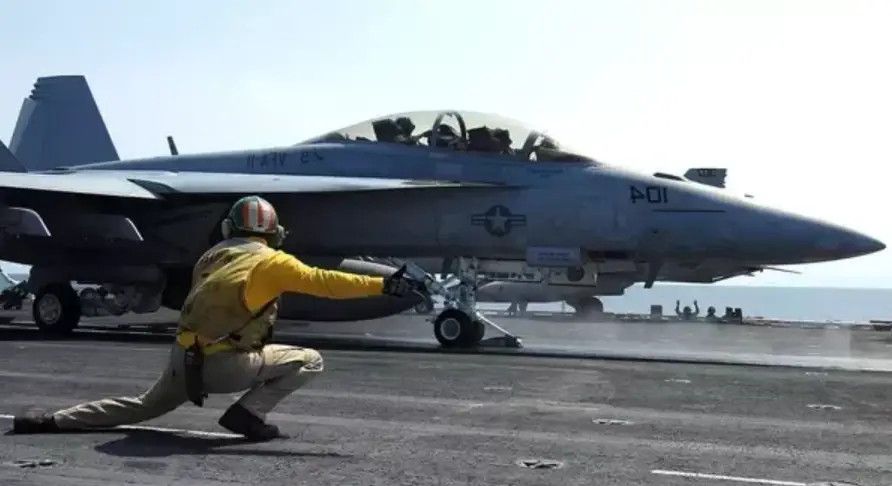
Aircraft Catapult in Aircraft Carrier
It’s impossible to discuss the history and development of catapults without acknowledging the significant contributions of Leonardo da Vinci. The da Vinci catapult, with its innovative design and the fascinating physics behind it, is a testament to Leonardo’s genius and far-reaching vision.
Although not brought to life during his time, the Leonardo da Vinci catapult has not only provided us with a deeper understanding of the genius that was Leonardo but also has served as an inspiration for modern mechanical studies and designs.
The impact of Leonardo’s catapult design extends beyond just warfare. Today, variations of the catapult are used in various fields, showcasing the adaptability of Leonardo’s designs. From launching aircrafts on naval carriers to educational tools in physics classes, the catapult’s usage in the modern world reflects its enduring relevance.